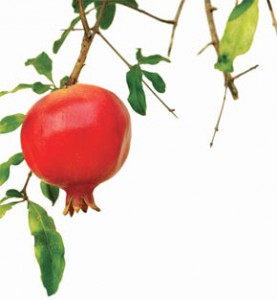 Q. Last winter I planted a bare root pomegranate. It has done very well, in fact it has nearly doubled in size but the growth is very leggy. Should I cut it back now to encourage branching, or wait until it is dormant? By pruning now will I cut off any potential fruit?
Q. Last winter I planted a bare root pomegranate. It has done very well, in fact it has nearly doubled in size but the growth is very leggy. Should I cut it back now to encourage branching, or wait until it is dormant? By pruning now will I cut off any potential fruit?
A. Pomegranates are pruned usually during January and February but you can start earlier when the leaves start to drop. They’re grown as a medium size shrub or a multi-stem small tree. There are three things you need to do when pruning pomegranates, eliminate the dead wood, remove the rubbing and crossing branches and then shape the plant by reducing the length of the growth. That being said, pomegranates naturally have long arching branches that gives it an arching, vase like form, so heavy pruning can alter the plant’s aesthetics. You preserve the natural tree look by removing branches to the trunk or larger limbs instead of an overall shearing. The canopy should be thinned out every three years, regardless of the growth form. Of course all of this is a judgment call on your part, as there are many correct methods of shaping depending on the location and the plants surrounding it. Pruning can affect the size of the crop as the fruit forms on new wood. Hence, it’s important to feed annually in the early spring with a complete fertilizer to encourage the new growth.
Pomegranates are one of the easiest fruits to grow. The Spaniards introduced them into California in the sixteen-century. They’re native to southern Europe and spread throughout California with the establishment of the missions. Today they’re being rediscovered by a new generation of gardeners just like blueberries. They’re popular for the following reasons. Pomegranates are high in antioxidants and easy to grow in a wide variety of soils or in containers. They’re somewhat drought tolerant and not affected by many pests or diseases. The bright orange tubular flowers attract hummingbirds and are a popular plant choice for bonsai. Wonderful and Eversweet are the two most widely available varieties, but there are many others. And finally, you’ll also find Punica Granatum is a non-fruiting landscape shrub that is available in our area. It grows to four feet with a three-foot spread, so it’s very adaptable to small yards.
Q. The onions I planted this year had a problem. Seed stalks develop when the plants were still very small. Why do onions go to seed so early?
A. When onions go to seed, it’s called bolting. The primary cause of bolting in the Bay Areas is weather related stress due to changes in temperature. Onions are best planted in the fall and late winter through the early spring. Onions planted April through June go to seed the first time the temperatures climb into the 80’s. Onion sets are now available while the sweet Bermuda Onions plants that are Stockton Red, Torpedo Sweet Yellow and White, in early November.
Buzz Bertolero is Executive Vice President of Navlet’s Garden Centers and a California Certified Nursery Professional. His web address is www.dirtgardener.com and you can send questions by email at dirtgarden@aol.com or to 360 Civic Drive Ste. ‘D’, Pleasant Hill, Calif. 94523 and on Facebook at Facebook/.com/Buzz-Bertolero
Leave a Reply